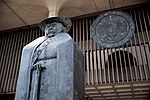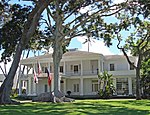Hawaii State Capitol

The Hawaii State Capitol is the official statehouse or capitol building of the U.S. state of Hawaii. From its chambers, the executive and legislative branches perform the duties involved in governing the state. The Hawaii State Legislature—composed of the twenty-five member Hawaii State Senate led by the President of the Senate and the fifty-one member Hawaii State House of Representatives led by the Speaker of the House—convenes in the building. Its principal tenants are the Governor of Hawaii and Lieutenant Governor of Hawaii, as well as all legislative offices and the Legislative Reference Bureau. Located in downtown Honolulu, the Hawaii State Capitol was commissioned and dedicated by John A. Burns, second Governor of Hawaii. It opened on March 15, 1969, replacing the former statehouse, the ʻIolani Palace.
Excerpt from the Wikipedia article Hawaii State Capitol (License: CC BY-SA 3.0, Authors, Images).Hawaii State Capitol
South Beretania Street, Honolulu Hawaii Capital Historic District
Geographical coordinates (GPS) Address External links Nearby Places Show on map
Geographical coordinates (GPS)
| Latitude | Longitude |
|---|---|
| N 21.3075 ° | E -157.8575 ° |
Address
Hawaii State Capitol
South Beretania Street 415
96813 Honolulu, Hawaii Capital Historic District
Hawaii, United States
Open on Google Maps








